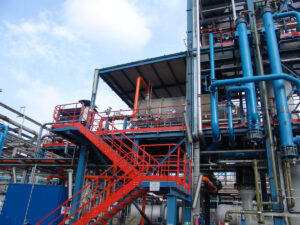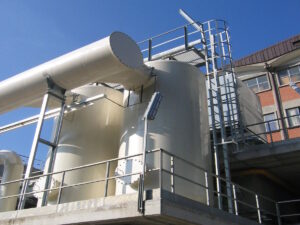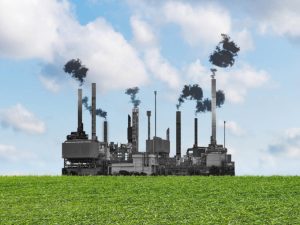- A well established reality in WEEE Waste Recycling industry
- Abatement target: chlorofluorocarbons and pentane coming from WEEE Waste recycling processes
- Multi-stage system for pollutant abatement: de-dusting, dehumidification, activated carbons adsorption, catalytic oxidation and wet treatment
- Multistage air pollutant treatment plant: energy recovery section, continuous control and monitoring.
- Optimal abatement results and full compliance
- Go to the gallery with all our systems
WEEE Waste Recycling: pollutant abatement solutions
This article examines technologies used to address the challenge of pollutant emissions that had to be implemented in order to ensure regulatory compliance and sustainable management of WEEE Waste recycling operations at a major industry player.
A well established reality in WEEE Waste Recycling industry
The customer we are talking about today operates in the industrial ecology sector and, in particular, in the recovery of plastic and metal materials from so-called WEEE, Waste Electrical and Electronic Equipment. This is a very experienced company that stands out for its expertise and services throughout the country. In particular, this company guarantees the collection and disposal of different types of waste, including WEEE.
WEEE recovery facilities: what is it all about?
In a very brief summary, the WEEE Waste Recycling activity takes place by means of a complex process of dismantling and shredding, with subsequent separation of the products, in order to obtain plastic and metals with a high level of purity. This process makes it possible to recycle materials such as iron, noble metals, precious metals, plastics, glass and wood that would otherwise be disposed of, making them reusable for industry, or allows their energy content to be valorised, contributing to sustainable waste management, a premise of any ecological policy.
Abatement target: chlorofluorocarbons and pentane coming from WEEE Waste recycling processes
As mentioned, the recovery of materials contained in WEEE is achieved through a series of processes of dismantling and shredding of the various components, with separation of the products. During these operations, the release of dust and polluting gases into the atmosphere is physiological. Closer examination revealed that there were emissions of Chlorofluorocarbons (CFCs) from the cooling circuits of some products and pentane present in various products such as insulating and expanding foams.
The regulation of refrigerant gases such as R12, R11, and Chlorofluorocarbons is quite stringent, as they cause a significant contribution to the greenhouse effect, and therefore required an advanced technological approach in the design phase of the abatement plant solution.
The main objective of the order was twofold:
- to ensure that WEEE Waste Recycling plants strictly comply with the emission standards set by the regulations, thus contributing to environmental protection.
- to propose advanced purification solutions in order to promote the full sustainability of the company’s operations, concretely supporting the client’s commitment to adopt eco-sustainable practices.
Multi-stage system for pollutant abatement: de-dusting, dehumidification, activated carbons adsorption, catalytic oxidation and wet treatment
The treatment of atmospheric emissions from recycling processes in WEEE Waste disposal requires the use of a multi-step technological approach. This necessity derives from the presence of multiple pollutants, which, if not adequately treated, can generate harmful by-products.
The emissions from this activity, in fact, are characterised by the coexistence of dust, high humidity, flammable hydrocarbons that can reach the explosive threshold, and halogenated compounds that produce corrosive acids. The presence of unexpected compounds that may lead to complications or reductions in the efficiency of the planned treatment systems must also be considered.
The ad-hoc designed pollutant abatement plant therefore envisages a sequential series of different treatment technologies, namely:
- dust abatement
- dehumidification
- adsorption on activated carbon
- thermal oxidation
- wet scrubber
The sequential implementation of these technologies represents a comprehensive and structured approach, and ensures efficient and accurate treatment of atmospheric emissions. It is an advanced methodology that reflects the client’s commitment to environmental sustainability and full adherence to current regulations.
Dust filtration
Obtained through the use of cyclonic separator filters and mechanical filters such as pocket air filters and bag filters, it was necessary in order to guarantee the absence of dust and particulates, also to protect the subsequent abatement stages.
Humidity reduction
High humidity levels can affect catalytic reactivity and, consequently, the overall performance of the system. To address this problem, the system has been equipped with condensation units sized by our technical department.
Activated carbon
Thanks to the use of industrial activated carbon filters, it was possible to prevent the possible presence of unwanted or unexpected compounds, ensuring complete purification before the thermal oxidation phase.
Catalytic thermal oxidation
The thermal oxidation phase is aimed at converting pentane and CFCs into carbon dioxide and water. Within the scope of this project, in order to strictly comply with the most stringent atmospheric limits, catalytic oxidation was adopted, which can guarantee the highest abatement efficiency even in the presence of particularly complex compounds to be oxidised.
Wet neutralisation
Considering that, during the CFC oxidation process, inorganic acids are generated, it was necessary to foresee a wet abatement stage through the installation of a wet scrubber, in order to complete the management of emissions.
Multistage air pollutant treatment plant: energy recovery section, continuous control and monitoring.
A key element of the completed plant is the energy recovery section, which is able to contribute significantly to reducing overall energy consumption. This feature not only amplifies the plant’s environmental effectiveness and reduces its operating costs, but also further reflects its adherence to concrete principles of sustainability in the industrial sphere.
The sophisticated instrumentation employed and the control logic applied made it possible to optimize all purification processes in detail. For example, advanced management has made it possible to limit the formation of liquid waste in the wet scrubber section, thus helping to minimize the environmental impact of the entire process. This attention to detail also fits perfectly into a responsible environmental management perspective.
Another distinctive aspect that characterises the designed plant is the adoption of technological solutions for continuous monitoring realised through the use of sophisticated instrumentation, assisted by software specifically developed for the customer by Brofind’s electrical-instrument department. This technological solution has the dual purpose of:
- provide real-time analysis of overall plant performance
- actively assist the client in the complex processing of pollutant mass balances required by certifying authorities.
The adopted approach confirms the constant focus on regulatory compliance and fulfilment of sector-specific licensing requirements.
Optimal abatement results and full compliance
The emission treatment plant, designed and built as described above, has achieved significant success, exceeding the limits imposed on atmospheric emissions by a wide margin, both in terms of concentration and in terms of the mass flow of pollutants emitted downstream of the various purification stages.



